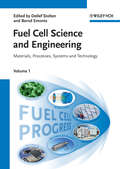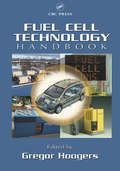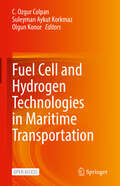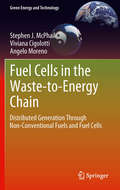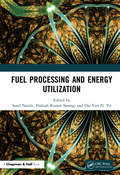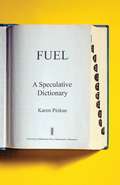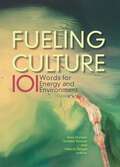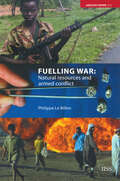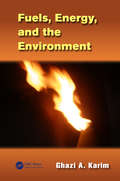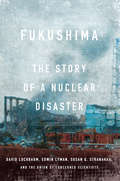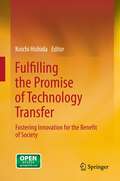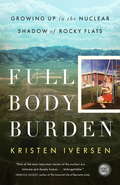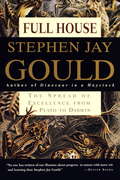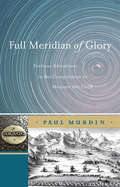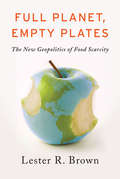- Table View
- List View
Fuel Cell Science and Engineering, 2 Volume Set: Materials, Processes, Systems and Technology
by Bernd Emonts Prof. Detlef StoltenFuel cells are expected to play a major role in the future power supply that will transform to renewable, decentralized and fluctuating primary energies. At the same time the share of electric power will continually increase at the expense of thermal and mechanical energy not just in transportation, but also in households. Hydrogen as a perfect fuel for fuel cells and an outstanding and efficient means of bulk storage for renewable energy will spearhead this development together with fuel cells. Moreover, small fuel cells hold great potential for portable devices such as gadgets and medical applications such as pacemakers. This handbook will explore specific fuel cells within and beyond the mainstream development and focuses on materials and production processes for both SOFC and lowtemperature fuel cells, analytics and diagnostics for fuel cells, modeling and simulation as well as balance of plant design and components. As fuel cells are getting increasingly sophisticated and industrially developed the issues of quality assurance and methodology of development are included in this handbook. The contributions to this book come from an international panel of experts from academia, industry, institutions and government. This handbook is oriented toward people looking for detailed information on specific fuel cell types, their materials, production processes, modeling and analytics. Overview information on the contrary on mainstream fuel cells and applications are provided in the book 'Hydrogen and Fuel Cells', published in 2010.
Fuel Cell Technology Handbook
by Gregor HoogersFuel cell systems have now reached a degree of technological maturity and appear destined to form the cornerstone of future energy technologies. But the rapid advances in fuel cell system development have left current information available only in scattered journals and Internet sites. The even faster race toward fuel cell commercialization further
Fuel Cell and Hydrogen Technologies in Aviation (Sustainable Aviation)
by Can Ozgur Colpan Ankica KovačThis book explores cutting-edge topics on hydrogen and fuel cell technologies in aviation. Coverage includes comparisons with conventional technologies, hydrogen storage options, energy management strategies, life cycle assessment, and application of fuel cells in different aerial vehicle classes. It also offers insights into recent progress and new technological developments in the field, along with case studies and practical applications. Fuel Cell and Hydrogen Technologies in Aviation is an invaluable guide for students, researchers, and engineers working on sustainable air transportation and the performance and environmental analysis of fuel cell-powered aerial vehicles.
Fuel Cell and Hydrogen Technologies in Maritime Transportation
by C. Ozgur Colpan Suleyman Aykut Korkmaz Olgun KonurFuel Cell and Hydrogen Technologies in Maritime Transportation looks at the role of hydrogen and fuel cells in creating a more sustainable and environmentally friendly maritime industry. It explores how hydrogen can revolutionize marine propulsion and highlights innovations and solutions for greener energy, including onboard hydrogen production, hybrid energy systems, and advanced fuel cell technologies. The book also covers performance and environmental analysis techniques for fuel cell-powered marine vessels, different fuel options, regulatory and safety considerations, and port-based hydrogen infrastructure. It provides insights into developing hydrogen infrastructure at ports and harbors and the economic implications and ecological benefits of adopting green hydrogen in maritime transportation. This resource is a must-read for engineers, maritime professionals, researchers, and marine enthusiasts who want to stay up-to-date with the changing landscape of sustainable marine transportation. Provides guidelines on the design and modeling of fuel cell-powered marine vessels; Discusses hydrogen safety and storage options; Includes detailed case studies and life cycle assessments for hydrogen-fueled marine vehicles. Chapter "Sustainable Waterborne Transportation with Hydrogen: An ecosystem approach to design" is available open access under a Creative Commons Attribution 4.0 International License via link.springer.com.
Fuel Cells
by Klaus-Dieter KreuerThe expected end of the "oil age" will lead to increasing focus and reliance on alternative energy conversion devices, among which fuel cells have the potential to play an important role. Not only can phosphoric acid and solid oxide fuel cells already efficiently convert today's fossil fuels, including methane, into electricity, but other types of fuel cells, such as polymer electrolyte membrane fuel cells, have the potential to become the cornerstones of a possible future hydrogen economy. Featuring 21 peer-reviewed entries from the Encyclopedia of Sustainability Science and Technology, Fuel Cells offers concise yet comprehensive coverage of the current state of research and identifies key areas for future investigation. Internationally renowned specialists provide authoritative introductions to a wide variety of fuel cell types, and discuss materials, components, and systems for these technologies. The entries also cover sustainability and marketing considerations, including comparisons of fuel cells with alternative technologies.
Fuel Cells and Hydrogen Storage
by David Michael Mingos Andrew BocarslyS.C. Singhal and X.-D. Zhou: Solid Oxide Fuel Cells.- H. Wang and H.D. Abruña/: Electrocatalysis of Direct Alcohol Fuel Cells: Quantitative DEMS Studies.- J. Benziger, A. Bocarsly, M.J. Cheah, P.Majsztrik, B. Satterfield and Q. Zhao: Mechanical and Transport Properties of Nafion: Effects of Temperature and Water Activity.- S. Sachdeva, J. A. Turner, J.L. Horana and A. M. Herring: The Use of Heteropoly Acids in Proton Exchange Fuel Cells.- M. T. Kelly: Perspective on the Storage of Hydrogen: Past and Future.-
Fuel Cells in the Waste-to-Energy Chain
by Angelo Moreno Stephen J. Mcphail Viviana CigolottiAs the availability of fossils fuels becomes more limited, the negative impact of their consumption becomes an increasingly relevant factor in our choices with regards to primary energy sources. The exponentially increasing demand for energy is reflected in the mass generation of by-products and waste flows which characterize current society's development and use of fossil sources. The potential for recoverable material and energy in these ever-increasing refuse flows is huge, even after the separation of hazardous constituent elements, allowing safe and sustainable further exploitation of an otherwise 'wasted' resource. Fuel Cells in the Waste-to-Energy Chain explores the concept of waste-to-energy through a 5 step process which reflects the stages during the transformation of refuse flows to a valuable commodity such as clean energy. By providing selected, integrated alternatives to the current centralized, wasteful, fossil-fuel based infrastructure, Fuel Cells in the Waste-to-Energy Chain explores how the concept of waste-to-energy can be constructed and developed into a realistic solution. The entire spectrum of current and future energy problems is illuminated through the explanation of the operational, integration and marketing implications of high efficiency technological solutions using the real context of developed regions such as Europe. Up-to-date reviews are provided on the status of technology and demonstration, implementation and marketing perspectives. The detailed technological information and insight gathered from over twenty years of experience in the field makes Fuel Cells in the Waste-to-Energy Chain a valuable resource for all engineers and researchers in the fields of energy supply systems and waste conversion, as well as providing a key reference for discussions by policy makers, marketing experts and industry developers working in energy supply and waste management.
Fuel Cells: Principles, Design, and Analysis (Mechanical and Aerospace Engineering Series)
by Shripad T. Revankar Pradip MajumdarFuel Cells: Principles, Design, and Analysis considers the latest advances in fuel cell system development and deployment, and was written with engineering and science students in mind. This book provides readers with the fundamentals of fuel cell operation and design, and incorporates techniques and methods designed to analyze different fuel cell
Fuel Processing and Energy Utilization
by Prakash Kumar Sarangi Sonil Nanda Dai-Viet N. VoThis book provides different aspects on fuel processing and refinery for energy generation. Most updated research findings along with case studies, real scenario examples, and extensive analyses of original research work and literature reviews is included in this book.
Fuel Production with Heterogeneous Catalysis
by Jacinto SáThis book presents the current state of the art and future perspectives of the heterogeneous catalytic production of fuels, complete with reaction mechanism schemes, engineering solutions, and valuable industry insights. It describes production of fuels from renewable sources using environmentally friendly technologies, exposing the advantages and disadvantages of each production process and suggesting solutions to minimize the impact of fuel transportation. Comprised of chapters authored by leading experts in the field, this authoritative text conveys the importance of catalysis for the sustainable production of fuels.
Fuel: A Speculative Dictionary (Posthumanities #39)
by Karen PinkusFuel is an idiosyncratic, speculative dictionary of fuels, real and imagined, historical and futuristic, hopeless and utopian. Drawing on literature, film, and scientific treatises—most produced long before &“climate change&” was in circulation—Fuel argues for a distinction between energy (a system of power) and fuel (a substance, which can be thought of as &“potentiality&”) as it endeavors to undo the dream that we can simply switch to renewables and all will be golden.From &“Air&” to &“Zyklon B,&” entries in this unusual &“dictionary&” include Algae, Clathrates, Dilithium, Fleece, Goats, Theology, Whale Oil, and many, many more. The tone of the entries ranges as widely as the topics: from historical anecdotes (the Ford Fiesta &“boozemobile&”) to eccentric readings of the classics of &“energy lit&” (Germinal and Oil!); from literary observations (a high octane Odyssey?) to excursions into literary theory. The dictionary draws from an eccentric canon, including works by Jules Verne, George Eliot&’s Silas Marner, Paolo Bacigalupi&’s Windup Girl, and the Tom Cruise vehicle Oblivion, among others. A message from this ambitious project is that energy can be understood as a heterogeneous set of self-mystifying systems or machines that block access to thought as they fascinate us. Fuels emerge as more primal elements that the audience can grasp at various points along the way to consumption/combustion. This dictionary can help scramble our thinking about fuel—not in order to demonize energy and not in order to create a new hierarchy in which certain renewables take over from fossil fuels but instead to open up potential ways of interacting with real and imaginary substances, by wrenching them out of narrative and placing them into an idiosyncratic dictionary to be applied by readers into new narratives.
Fueling Culture: 101 Words for Energy and Environment
by Jennifer Wenzel Patricia YaegerHow has our relation to energy changed over time? What differences do particular energy sources make to human values, politics, and imagination? How have transitions from one energy source to another—from wood to coal, or from oil to solar to whatever comes next—transformed culture and society? What are the implications of uneven access to energy in the past, present, and future? Which concepts and theories clarify our relation to energy, and which just get in the way? Fueling Culture offers a compendium of keywords written by scholars and practitioners from around the world and across the humanities and social sciences. These keywords offer new ways of thinking about energy as both the source and the limit of how we inhabit culture, with the aim of opening up new ways of understanding the seemingly irresolvable contradictions of dependence upon unsustainable energy forms.Fueling Culture brings together writing that is risk-taking and interdisciplinary, drawing on insights from literary and cultural studies, environmental history and ecocriticism, political economy and political ecology, postcolonial and globalization studies, and materialisms old and new.Keywords in this volume include: Aboriginal, Accumulation, Addiction, Affect, America, Animal, Anthropocene, Architecture, Arctic, Automobile, Boom, Canada, Catastrophe, Change, Charcoal, China, Coal, Community, Corporation, Crisis, Dams, Demand, Detritus, Disaster, Ecology, Electricity, Embodiment, Ethics, Evolution, Exhaust, Fallout, Fiction, Fracking, Future, Gender, Green, Grids, Guilt, Identity, Image, Infrastructure, Innervation, Kerosene, Lebenskraft, Limits, Media, Metabolism, Middle East, Nature, Necessity, Networks, Nigeria, Nuclear, Petroviolence, Photography, Pipelines, Plastics, Renewable, Resilience, Risk, Roads, Rubber, Rural, Russia, Servers, Shame, Solar, Spill, Spiritual, Statistics, Surveillance, Sustainability, Tallow, Texas, Textiles, Utopia, Venezuela, Whaling, Wood, Work For a full list of keywords in and contributors to this volume, please go to: http://ow.ly/4mZZxV
Fuelling War: Natural Resources and Armed Conflicts (Adelphi series #373)
by Philippe Le BillonA generous endowment of natural resources should favour rapid economic and social development. The experience of countries like Angola and Iraq, however, suggests that resource wealth often proves a curse rather than a blessing. Billions of dollars from resource exploitation benefit repressive regimes and rebel groups, at a massive cost for local populations. This Adelphi Paper analyses the economic and political vulnerability of resource-dependent countries; assesses how resources influence the likelihood and course of conflicts; and discusses current initiatives to improve resource governance in the interest of peace. It concludes that long-term stability in resource-exporting regions will depend on their developmental outcomes, and calls for a broad reform agenda prioritising the basic needs and security of local populations.
Fuels And Chemicals From Oilseeds: Technology And Policy Options
by Robert P. Morgan Eugene B. ShultzWith the sharp rise in petroleum prices over the past decade, interest has grown in the possible use of plant and tree seed oils as diesel fuel substitutes or extenders and as chemical feedstocks in both the industrialized and the developing world. This book represents the first attempt to bring together science, technology, and policy aspects of this topic in one volume. The authors examine the chemical, biological, and energy-related resources available in commercial and wild plant oilseeds; the status of chemical processing efforts and of engine tests using agricultural diesel fuels; the potential economic, environmental, and social impacts of more extensive oilseed utilization; and current legislation aimed at stimulating commercialization of strategic renewable agricultural resources.
Fuels and Fuel-Additives
by S. P. Srivastava Jenõ HancsókExamines all stages of fuel production, from feedstocks to finished productsExploring chemical structures and properties, this book sheds new light on the current science and technology of producing energy efficient and environmentally friendly fuels. Moreover, it explains the role of fuel-additives in the production cycle. This expertly written and organized guide to fuels and fuel-additives also presents requirements, rules and regulations, including US and EU standards governing automotive emissions, fuel quality and specifications, alternate fuels, biofuels, antioxidants, deposit control detergents/dispersants, stabilizers, corrosion inhibitors, and polymeric fuel-additives.Fuels and Fuel-Additives covers all stages and facets of the production of engine fuels as well as heating and fuel oils. The book begins with a quick portrait of the future of fuels and fuel production. Then, it sets forth the regulations controlling exhaust gas emissions and fuel quality from around the world. Next, the book covers:Processing of engine fuels derived from crude oil, including the production of blending componentsProduction of alternative fuelsFuel-additives for automotive enginesBlending of fuelsKey properties of motor fuels and their effects on engines and the environmentAviation fuelsThe final chapter of the book deals with fuel oils and marine fuels. Each chapter is extensively referenced, providing a gateway to the primary and secondary literature in the field. At the end of the book, a convenient glossary defines all the key terms used in the book.Examining the full production cycle from feedstocks to final products, Fuels and Fuel-Additives is recommended for students, engineers, and scientists working in fuels and energy production.
Fuels, Chemicals and Materials from the Oceans and Aquatic Sources
by Francesca M. Kerton Ning YanFuels, Chemicals and Materials from the Oceans and Aquatic Sources provides a holistic view of fuels, chemicals and materials from renewable sources in the oceans and other aquatic media. It presents established and recent results regarding the use of water-based biomass, both plants and animals,for value-added applications beyond food. The book begins with an introductory chapter which provides an overview of ocean and aquatic sources for the production of chemicals and materials. Subsequent chapters focus on the use of various ocean bioresources and feedstocks, including microalgae, macroalgae, and waste from aquaculture and fishing industries, including fish oils, crustacean and mollusc shells. Fuels, Chemicals and Materials from the Oceans and Aquatic Sources serves as a valuable reference for academic and industrial professionals working on the production of chemicals, materials and fuels from renewable feedstocks. It will also prove useful for researchers in the fields of green and sustainable chemistry, marine sciences and biotechnology. Topics covered include:• Production and conversion of green macroalgae• Marine macroalgal biomass as an energy feedstock• Microalgae bioproduction• Bioproduction and utilization of chitin and chitosan• Applications of mollusc shells• Crude fish oil as a potential fuel
Fuels, Energy, and the Environment
by Ghazi A. KarimThe need for cleaner, sustainable energy continues to drive engineering research, development, and capital projects. Recent advances in combustion science and technology, including sophisticated diagnostic and control equipment, have enabled engineers to improve fuel processes and systems and reduce the damaging effects of fuels on the environment.
Fukushima
by The Union of Concerned Scientists David Lochbaum Edwin Lyman Susan Q. Stranahan"A gripping, suspenseful page-turner" (Kirkus Reviews) with a "fast-paced, detailed narrative that moves like a thriller" (International Business Times), Fukushima teams two leading experts from the Union of Concerned Scientists, David Lochbaum and Edwin Lyman, with award-winning journalist Susan Q. Stranahan to give us the first definitive account of the 2011 disaster that led to the worst nuclear catastrophe since Chernobyl.Four years have passed since the day the world watched in horror as an earthquake large enough to shift the Earth's axis by several inches sent a massive tsunami toward the Japanese coast and Fukushima Daiichi nuclear power plant, causing the reactors' safety systems to fail and explosions to reduce concrete and steel buildings to rubble. Even as the consequences of the 2011 disaster continue to exact their terrible price on the people of Japan and on the world, Fukushima addresses the grim questions at the heart of the nuclear debate: could a similar catastrophe happen again, and--most important of all--how can such a crisis be averted?
Fukushima
by The Union of Concerned Scientists David Lochbaum Edwin Lyman Susan Q. StranahanOn March 11, 2011, an earthquake large enough to knock the earth from its axis sent a massive tsunami speeding toward the Japanese coast and the aging and vulnerable Fukushima Daiichi nuclear power reactors. Over the following weeks, the world watched in horror as a natural disaster became a man-made catastrophe: fail-safes failed, cooling systems shut down, nuclear rods melted. In the first definitive account of the Fukushima disaster, two leading experts from the Union of Concerned Scientists, David Lochbaum and Edwin Lyman, team up with journalist Susan Q. Stranahan, the lead reporter of the Philadelphia Inquirer's Pulitzer Prize-winning coverage of the Three Mile Island accident, to tell this harrowing story. Fukushima combines a fast-paced, riveting account of the tsunami and the nuclear emergency it created with an explanation of the science and technology behind the meltdown as it unfolded in real time. Bolstered by photographs, explanatory diagrams, and a comprehensive glossary, the narrative also extends to other severe nuclear accidents to address both the terrifying question of whether it could happen elsewhere and how such a crisis can be averted in the future.
Fukushima
by Mark HeleyFukushima: What You Need to Know is a concise but comprehensive guide to the disaster at Fukushima and its ongoing consequences. Presenting a solution-based approach, Mark Heley details the current problems and future potential risks and offers balanced information about what we can do about them. The book covers: * The extent of the pollution from Fukushima and what and where the dangers are * The real risks from radiological pollution and the protective measures you can take * Possible solutions for stopping the ongoing contamination and cleaning up the damage already done * A call for meaningful international collaboration and the ending of the era of secrecy and cover-ups about the risks of nuclear power
Fulfilling the Promise of Technology Transfer: Fostering Innovation for the Benefit of Society
by Koichi HishidaUniversities and research institutes are increasingly expected to contribute to society by creating innovation from the returns of their research results and the establishment of new technologies. Toward that goal, Keio University in Japan held an international symposium titled "Fulfilling the Promise of Technology Transfer: Fostering Innovation for the Benefit of Society." From that symposium the following contents are included in the present volume: 1) A showcase of ideas and case studies to promote future creation of innovation by universities and research institutes worldwide, including information on the R&D value chain, licensing, income generation, start-ups and mechanisms to encourage entrepreneurship, and the changing role of universities in fostering innovation. 2) Introduction of active research projects that aim to productize successful research results on an international level. For example, the book includes results of research on stem cell technologies and regenerative medicine as well as the realization and application of polymer photonics and the development of the core technology of polymer photonics. 3) Case studies from the U.K. in developing industry-academia collaboration with various business partners ranging from start-ups and spinout companies to large enterprises. 4) Reports of the achievements of the technological transfer activities at Keio University supported by the 5-year public fund, with suggestions for future prospects.
Full Body Burden: Growing Up in the Nuclear Shadow of Rocky Flats
by Kristen IversenFull Body Burden is a haunting work of narrative nonfiction about a young woman, Kristen Iversen, growing up in a small Colorado town close to Rocky Flats, a secret nuclear weapons plant once designated "the most contaminated site in America." It's the story of a childhood and adolescence in the shadow of the Cold War, in a landscape at once startlingly beautiful and--unknown to those who lived there--tainted with invisible yet deadly particles of plutonium. It's also a book about the destructive power of secrets--both family and government. Her father's hidden liquor bottles, the strange cancers in children in the neighborhood, the truth about what was made at Rocky Flats (cleaning supplies, her mother guessed)--best not to inquire too deeply into any of it. But as Iversen grew older, she began to ask questions. She learned about the infamous 1969 Mother's Day fire, in which a few scraps of plutonium spontaneously ignited and--despite the desperate efforts of firefighters--came perilously close to a "criticality," the deadly blue flash that signals a nuclear chain reaction. Intense heat and radiation almost melted the roof, which nearly resulted in an explosion that would have had devastating consequences for the entire Denver metro area. Yet the only mention of the fire was on page 28 of the Rocky Mountain News, underneath a photo of the Pet of the Week. In her early thirties, Iversen even worked at Rocky Flats for a time, typing up memos in which accidents were always called "incidents."And as this memoir unfolds, it reveals itself as a brilliant work of investigative journalism--a detailed and shocking account of the government's sustained attempt to conceal the effects of the toxic and radioactive waste released by Rocky Flats, and of local residents' vain attempts to seek justice in court. Here, too, are vivid portraits of former Rocky Flats workers--from the healthy, who regard their work at the plant with pride and patriotism, to the ill or dying, who battle for compensation for cancers they got on the job. Based on extensive interviews, FBI and EPA documents, and class-action testimony, this taut, beautifully written book promises to have a very long half-life.
Full House: The Spread of Excellence from Plato to Darwin
by Stephen Jay GouldFew would question the truism that humankind is the crowning achievement of evolution; that the defining thrust of life's history yields progress over time from the primitive and simple to the more advanced and complex; that the disappearance of .400 hitting in baseball is a fact to be bemoaned; or that identifying an existing trend can be helpful in making important life decisions. Few, that is, except Stephen Jay Gould who, in his new book Full House: The Spread of Excellence from Plato to Darwin, proves that all of these intuitive truths are, in fact, wrong. "All of these mistaken beliefs arise out of the same analytical flaw in our reasoning, our Platonic tendency to reduce a broad spectrum to a single, pinpointed essence," says Gould. "This way of thinking allows us to confirm our most ingrained biases that humans are the supreme being on this planet; that all things are inherently driven to become more complex; and that almost any subject can be expressed and understood in terms of an average." In Full House, Gould shows why a more accurate way of understanding our world (and the history of life) is to look at a given subject within its own context, to see it as a part of a spectrum of variation rather than as an isolated "thing" and then to reconceptualize trends as expansion or contraction of this "full house" of variation, and not as the progress or degeneration of an average value, or single thing. When approached in such a way, the disappearance of .400 hitting becomes a cause for celebration, signaling not a decline in greatness but instead an improvement in the overall level of play in baseball; trends become subject to suspicion, and too often, only a tool of those seeking to advance a particular agenda; and the "Age of Man" (a claim rooted in hubris, not in fact) more accurately becomes the "Age of Bacteria." "The traditional mode of thinking has led us to draw many conclusions that don't make satisfying sense," says Gould. "It tells us that .400 hitting has disappeared because batters have gotten worse, but how can that be true when record performances have improved in almost any athletic activity?" In a personal eureka!, Gould realized that we were looking at the picture backward, and that a simple conceptual inversion would resolve a number of the paradoxes of the conventional view. While Full House deftly reveals the shortcomings of the popular reasoning we apply to everyday life situations, Gould also explores his beloved realm of natural history as well. Whether debunking the myth of the successful evolution of the horse (he grants that the story still deserves distinction, but as the icon of evolutionary failure); presenting evidence that the vaunted "progress of life" is really random motion away from simple beginnings, not directed impetus toward complexity; or relegating the kingdoms of Animalai and Plantae to their proper positions on the genealogical chart for all of life (as mere twigs on one of the three bushes), Full House asks nothing less than that we reconceptualize our view of life in a fundamental way.
Full Meridian of Glory
by Paul Murdin[the text below needs editing and we must be careful not to say things about Dan Brown's book that could get Springer in legal trouble] Dan Brown's novel, The Da Vinci Code, was first published in 2003; its sales have reached 40 million worldwide. The book mixes a small spice of fact into a large dollop of fiction to create an entertaining novel of intrigue, adventure, romance, danger and conspiracy, which have been imaginatively worked together to cook up the successful bestseller. Most interest in the book's origins has centred on the sensational religious aspects. Dan Brown has written: 'All of the art, architecture, secret rituals, secret societies, all of that is historical fact.' This gives an air of authenticity to the book. Brown has, however, made up the religious doctrines, or based them on questionable accounts by others. The locations of the actions of The Da Vinci Code are not, however, made up. The present book is the scientific story behind the scene of several of the book's actions that take place on the axis of France that passes through Paris. The Paris Meridian is the name of this location. It is the line running north-south through the astronomical observatory in Paris. One of the original intentions behind the founding of the Paris Observatory was to determine and measure this line. The French government financed the Paris Academy of Sciences to do so in the seventeenth to nineteenth centuries. It employed both astronomers - people who study and measure the stars - and geodesists - people who study and measure the Earth. This book is about what they did and why. It is a true story behind Dan Brown's fiction. This is the first English language presentation of this historical material. It is attractively written and it features the story of the community of scientists who created the Paris Meridian. They knew each other well - some were members of the same families, in one case of four generations. Like scientists everywhere they collaborated and formed alliances; they also split into warring factions and squabbled. They travelled to foreign countries, somehow transcending the national and political disputes, as scientists do now, their eyes fixed on ideas of accuracy, truth and objective, enduring values - save where the reception given to their own work is concerned, when some became blind to high ideals and descended into petty politics. To establish the Paris Meridian, the scientists endured hardship, survived danger and gloried in amazing adventures during a time of turmoil in Europe, the French Revolution and the Napoleonic War between France and Spain. Some were accused of witchcraft. Some of their associates lost their heads on the guillotine. Some died of disease. Some won honour and fame. One became the Head of State in France, albeit for no more than a few weeks. Some found dangerous love in foreign countries. One scientist killed in self defence when attacked by a jealous lover, another was himself killed by a jealous lover, a third brought back a woman to France and then jilted her, whereupon she joined a convent. The scientists worked on practical problems of interest to the government and to the people. They also worked on one of the important intellectual problems of the time, a problem of great interest to their fellow scientists all over the world, nothing less than the theory of universal gravitation. They succeeded in their intellectual work, while touching politics and the affairs of state. Their endeavours have left their marks on the landscape, in art and in literature.
Full Planet, Empty Plates: The New Geopolitics of Food Scarcity
by Lester R. Brown<P> With food supplies tightening, countries are competing for the land and water resources needed to feed their people. <P> With food scarcity driven by falling water tables, eroding soils, and rising temperatures, control of arable land and water resources is moving to center stage in the global struggle for food security. “In this era of tightening world food supplies, the ability to grow food is fast becoming a new form of geopolitical leverage. Food is the new oil,” Lester R. Brown writes. <P> What will the geopolitics of food look like in a new era dominated by scarcity and food nationalism? Brown outlines the political implications of land acquisitions by grain-importing countries in Africa and elsewhere as well as the world’s shrinking buffers against poor harvests. With wisdom accumulated over decades of tracking agricultural issues, Brown exposes the increasingly volatile food situation the world is facing.
